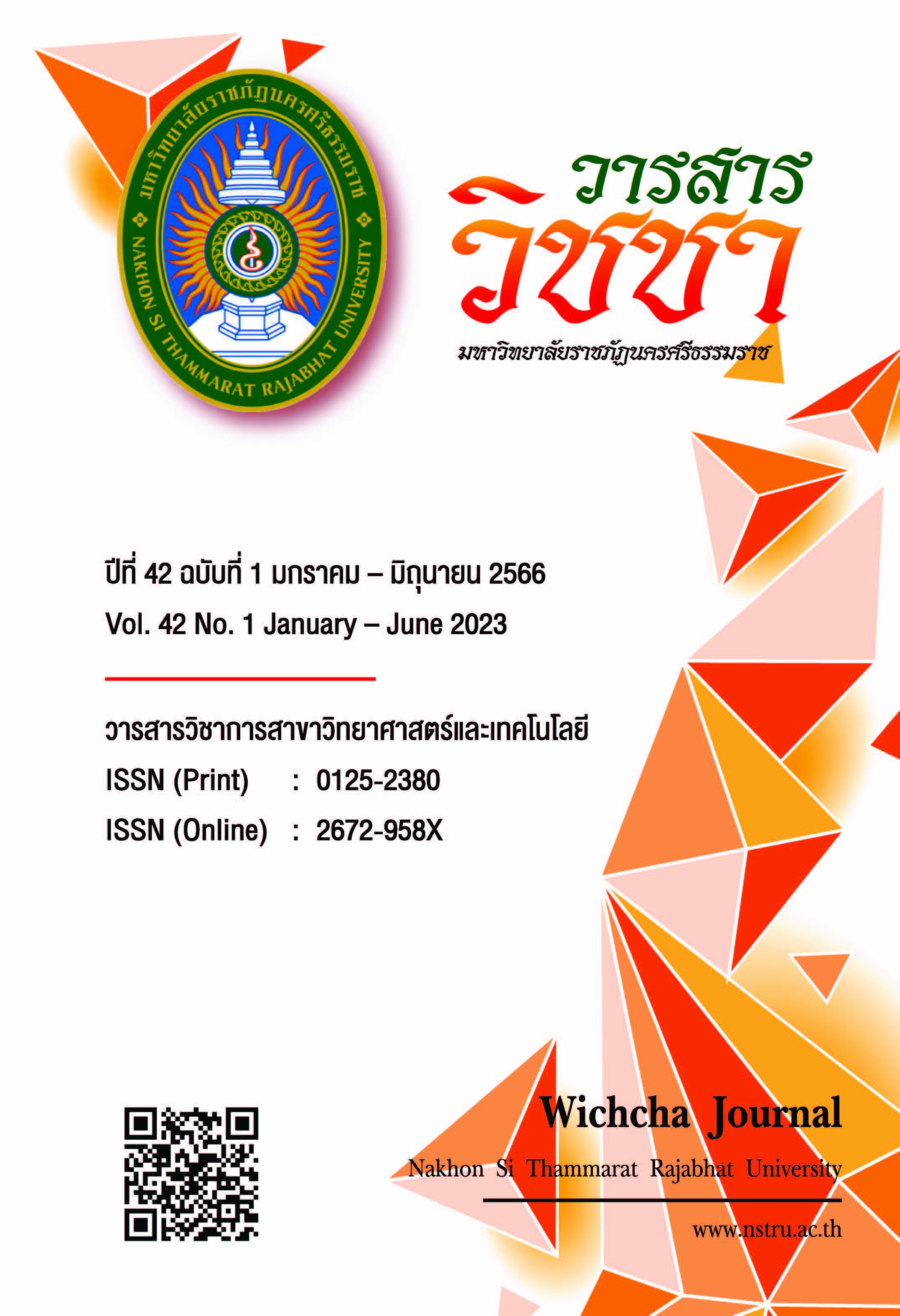Development of Biodegradable Pots from Wastes of Cockle Mushroom Cultivation
Main Article Content
Abstract
Unleavened cockle mushroom lumps from mushroom cultivation were often eliminated by piles in the rubber plantations for decomposing in nature or incineration, resulting in an impact on the environment. However, the wood sawdust contained in the mushroom lumps is a natural material that can be developed into a seedling pot. Thus, the objective of this research is to develop the seedling pot from unleavened mushroom lumps, which investigates the effect of sawdust from unleavened cockle mushroom lumps in a range of 120-150 grams and concentration of the binder form cassava starch in a range of 100-150 grams per half liter of water. The results from the experiment showed that an increase of sawdust from old cockerel lumps as a pot mixture in range of 120-150 grams resulted in an increase of water absorption percentage with the same concentration of cassava starch. Also, an increase of sawdust as a pot mixture in range of 120-135 grams resulted in an increase in vertical and horizontal compressive forces with the amount of wood sawdust. Likewise, it was also found that with the same amount of sawdust, an increase of cassava starch concentration in range of 100-150 grams per half liter of water resulting in percentage of porosity and percentage of water absorption was reduced, but the vertical and horizontal compressive forces clearly increased with concentration of the binder. Furthermore, the pots from sawdust in all formulations had no cracks or any damage when dropped from a height of 60 centimeter. Finally, the seedling pot made from 120 grams of sawdust and 150 grams of tapioca starch per half liter of water is suitable for use in the production of seedling pots due to the best growth of plants in different dimensions. As a result, the sawdust from old mushroom lumps contains high amounts of major trace elements, and rubberwood sawdust contains more primary nutrients than other wood sawdust.
Article Details

This work is licensed under a Creative Commons Attribution-NonCommercial-NoDerivatives 4.0 International License.
เนื้อหาและข้อมูลในบทความที่ลงตีพิมพ์ในวารสารวิชชา มหาวิทยาลัยราชภัฏนครศรีธรรมราช ถือเป็นข้อคิดเห็นและความรับผิดชอบของผู้เขียนบทความโดยตรง ซึ่งกองบรรณาธิการวารสารไม่จำเป็นต้องเห็นด้วยหรือร่วมรับผิดชอบใด ๆ
บทความ ข้อมูล เนื้อหา รูปภาพ ฯลฯ ที่ได้รับการตีพิมพ์ในวารสารวิชชา มหาวิทยาลัยราชภัฏนครศรีธรรมราช ถือเป็นลิขสิทธ์ของวารสารวิชชา มหาวิทยาลัยราชภัฏนครศรีธรรมราช หากบุคคลหรือหน่วยงานใดต้องการนำข้อมูลทั้งหมดหรือส่วนหนึ่งส่วนใดไปเผยแพร่ต่อหรือเพื่อการกระทำการใด ๆ จะต้องได้รับอนุญาตเป็นลายลักษณ์อักษรจากวารสารวิชชา มหาวิทยาลัยราชภัฏนครศรีธรรมราชก่อนเท่านั้น
The content and information in the article published in Wichcha journal Nakhon Si Thammarat Rajabhat University, It is the opinion and responsibility of the author of the article. The editorial journals do not need to agree. Or share any responsibility.
References
กิตติชัย โสพันนา วิชชุดา ภาโสม กนกวรรณ วรดง และอนันตสิทธิ์ ไชยวังราช. (2558). การประดิษฐ์และสมบัติของกระถางชีวภาพ. SNRU Journal of Science and Technology, 7(2), 1-7.
จารุวรรณ มณีศรี. (2547). การใช้ขี้เลื่อยไม้ยางพาราเป็นสับสเตรทในการผลิตเอนไซม์เซลลูเลส. ใน การประชุมทางวิชาการของมหาวิทยาลัยเกษตรศาสตร์ ครั้งที่ 42 (หน้า 347-353). กรุงเทพฯ: มหาวิทยาลัยเกษตรศาสตร์.
จุฑามาศ แก้วมณี. (2564). การผลิตกระถางต้นไม้ย่อยสลายได้จากกากตะกอนโรงงานยางพาราร่วมกับวัสดุเหลือทิ้งจากก้อนเชื้อเห็ดและทะลายปาล์ม. ASEAN Journal of Scientific and Technological Reports, 24(1), 84-93.
ชัชวินทร์ นวลศรี จักรกฤช ศรีละออ คงเดช พะสีนาม ธันวมาส กาศสนุก ปุณณดา ทะรังสี และนนทพร รัตนจักร์. (2563). การพัฒนากระถางต้นไม้ชีวภาพจากฝุ่นผงใบยาสูบร่วมกับปุ๋ยหมักและปุ๋ยคอก. แก่นเกษตร, 48(พิเศษ 1), 1003-1010.
เตือนใจ ปิยัง วรรณวิภา ไชยชาญ และกัตตินาฏ สกุลสวัสดิพันธ์. (2561). การผลิตกระถางต้นไม้ที่เป็นมิตรต่อสิ่งแวดล้อมจากกากตะกอนน้ำมันปาล์มและวัสดุเหลือทิ้งจากการเพาะเห็ด. วารสารวิจัย มหาวิทยาลัยเทคโนโลยีราชมงคลศรีวิชัย, 10(3), 497-511.
นศพร ธรรมโชติ ชวกร มุกสาน ชโลธร ศักดิ์มาศ เศรษฐวัฒน์ ถนิมกาญจน์ และชาตรี หอมเขียว. (2565). สมบัติทางกายภาพของกระถางเพาะกล้าไม้ที่มีอัตราส่วนผสมระหว่างทะลายปาล์มน้ำมันต่อขี้เลื่อยไม้ยางพารา. วารสารวิศวกรรมศาสตร์และนวัตกรรม, 15(1), 65-74.
นิพนธ์ ตันไพบูลย์กุล ธรพร บุศย์น้ำเพชร กนกวรรณ ศุกรนันทน์ และพิมผกา โพธิลังกา. (2565). กระถางชีวภาพจากผักตบชวาโดยใช้แป้งมันสำปะหลังและกากมันสำปะหลังเป็นตัวประสาน. วารสารวิทยาศาสตร์และเทคโนโลยี หัวเฉียวเฉลิมพระเกียรติ, 8(1), 56-69.
ปิ่นประภา โสมากุล และสิรินารี เงินเจริญ. (2563). กระถางเพาะชำที่ย่อยสลายได้จากขุยฉลากและขุยมะพร้าว. ใน การประชุมวิชาการ ครั้งที่ 4 มหาวิทยาลัยเกษตรศาสตร์ วิทยาเขตศรีราชา (หน้า 36-45). ชลบุรี: มหาวิทยาลัยเกษตรศาสตร์.
พรฤดี สงวนสุข. (2552). การพัฒนาบรรจุภัณฑ์กระถางจากกากตะกอนน้ำมันปาล์มและกากตะกอนเยื่อกระดาษจากบ่อบําบัดน้ำเสียสําหรับกล้าไม้. วิทยานิพนธ์วิทยาศาสตรมหาบัณฑิต (เทคโนโลยีการบรรจุ). มหาวิทยาลัยเกษตรศาสตร์, กรุงเทพฯ.
พรศิลป์ สีเผือก ชัยสิทธิ์ ปรีชา และวุฒิชัย สีเผือก. (2559-2560). ความหลากหลายของเชื้อราและแบคทีเรียในก้อนเชื้อเห็ดเก่าและแนวทางการใช้ประโยชน์. รายงานวิจัย. มหาวิทยาลัยเทคโนโลยีราชมงคลศรีวิชัย.
วรรณวิภา ไชยชาญ เอนก สาวะอินทร์ และวีระศักดิ์ ไชยชาญ. (2561). ธาตุอาหารของพืชและระยะเวลาการย่อยสลายของกระถางเพาะชำชีวภาพ. วารสารวิชชา มหาวิทยาลัยราชภัฏนครศรีธรรมราช, 37(พิเศษ), 12-26.
ศิริศักดิ์ แสนสุขกะโต และจรัสชัย เย็นพยับ. (2562). การศึกษาอัตราส่วนการผสมและคุณภาพของกระถางปลูกจากวัสดุเหลือใช้จากมะพร้าว. แก่นเกษตร, 47(พิเศษ 1), 1485-1490.
สำนักงานพัฒนาวิทยาศาสตร์และเทคโนโลยีแห่งชาติ. (2563). BCG economy model คืออะไร. สืบค้นเมื่อ 14 ตุลาคม 2565, จาก: https://www.nstda.or.th/home/knowledge_post/what-is-bcg-economy-model/.
อัจฉรา บุญโรจน์ และวัชรวิทย์ รัศมี. (2559). การเพิ่มมูลค่าขี้เลื่อยเหลือทิ้งจากการเพาะเห็ดโดยการหมักร่วมกับมูลไก่เพื่อทำเป็นปุ๋ยหมัก. ใน การประชุมวิชาการระดับชาติ ครั้งที่ 8 มหาวิทยาลัยราชภัฏนครปฐม (หน้า 58-64). นครปฐม: มหาวิทยาลัยราชภัฏนครปฐม.
American Society for Testing and Materials (ASTM). (2019). Standard test method for drop test of loaded containers by free fall: ASTM D5276. Pennsylvania: ASTM International.
American Society for Testing and Materials (ASTM). (2020). Standard test method for determining compressive resistance of shipping containers, components, and unit loads: ASTM D642. Pennsylvania: ASTM International.
Jirapornvaree, I., Suppadit, T. and Popan, A. (2017). Use of pineapple waste for production of decomposable pots. International Journal of Recycling of Organic Waste in Agriculture, 6, 345-350, doi: https://doi.org/10.1007/s40093-017-0183-5.
TAPPI T 441. (2013). Water absorptiveness of sized (non-bibulous) paper, paperboard, and corrugated fiberboard (Cobb test). Chicago: Technical Association of the Pulp and Paper Industry.


